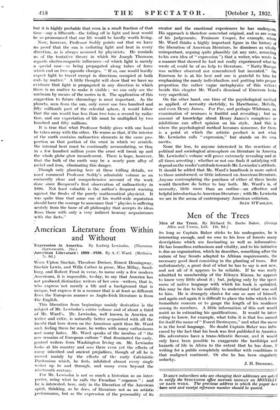A New Lease of Life ?
THE general. reader, " seeking to understand the world in which he lives," will find this book a sure guide to those fascinating discoveries in which Professor Soddy has taken so great a part. We may admit that, as Huck Finn said of Pilgrim's Progress, the statements are interesting but tough. But after adequate chewing they are eminently digestible, and those who absorb them will competently understand the latest views as to the nature of the atom and the constitution of matter.
Perhaps the novelty most gratifying to the optimist lies hi a revolutionary suggestion of- Professor Soddy's own as to the propagation of light. Those who look forward to the perfectibility of man and the wonderful ages of progress that lie before a scientifically organized world must be saddened when they think of the inevitable limit which modern science puts to the -life of humanity on the earth. Our history must one day end in a frozen collapse of all human endeavour, while the earth still spins through space a void and useless planet ; for the sun's days are numbered, and with them our collective earthly life. The latest theory holds that the suit, in order to keep up the output a light and heat on which all our activities depend, must be losing mass at the rat-,
of four hundred million tons a second. It is true that at this __rate__ the-sun. would.-last- fifteen million million years, but it is highly probable that even in a small fraction of that time—say a fifteenth—the falling off in light and heat would be so pronounced that our life would be hardly worth living.
Now, however, Professor Soddy points out that we have no proof that the sun is radiating light and heat in every direction, as is always assumed by physicists. He reminds us of the tentative theory in which Sir Joseph Thomson regards electro-magnetic influences—of which light is merely a special case—as being propagated along tubes of force which end on two opposite charges. " If so, one would hardly expect light to travel except in directions occupied at both ends by matter." A little thought will shoiv that we have na evidence that light is propagated in any direction in which there is no matter to make it visible ; we can only see the 'Sunbeam by means of the motes in it. The application of this ,suggestion to future chronology is most important. As the -planets, seen from the sun, only cover one two hundred and fifty millionth part of the celestial sphere, it would follow that the sun would lose less than two tons a second by radia- tion, and our expectation of life must be multiplied _by two hundred and fifty millions.
It is true that what Professor Soddy gives with one hand he takes away with the other. He warns us that, if the interior of the earth contains radioactive elements in the same pro- portion as that portion of the crust in which we scratch, the internal heat must be continually accumulating, so that in a few hundred million years the crust will break up and the whole globe glow incandescent. There is hope, however, that the bulk of the earth may be a nearly pure alloy of nickel and iron, eliminating this danger.
:Though only glancing here at these trifling details, we Must commend Professor Soddy's admirable volume as an .eminently clear and comprehensive account of the work -done since Becquerel's first observation of radioactivity in 1896. Not least valuable is the author's frequent warning against the freaks of the purely mathematical physicist. It was quite time that some one of his world-wide reputation should have the courage to announce that " physics is suffering acutely from the bane of all philosophy that accepts its ideas from those with only a very indirect hearsay acquaintance with the facts."















































 Previous page
Previous page